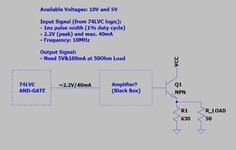wee_cookie_man
Newbie
Hello Everyone!
I have an electrical pulse which I need to amplify for further use. The generated signal has around 1ns pulse width (signal looks similar to a Gaussian curve) and a peak of circa 2.2V (max. 40mA).
Attached is a overview of the circuit.
Summary of the overall circuit:
I really appreciate any help from knowledgeable members,
Thanks you very much!
PS: I'm a bit lost after all the unsuccessful trials to get the signal amplified with a npn transistor circuit.
I have an electrical pulse which I need to amplify for further use. The generated signal has around 1ns pulse width (signal looks similar to a Gaussian curve) and a peak of circa 2.2V (max. 40mA).
Attached is a overview of the circuit.
Summary of the overall circuit:
- As supply voltages 10V and 5V are available
- The Input Signal comes from a AND-Gate (74LVC2G8), with 2.2V (peak) and circa. 40mA. Signal repeats every 100ns (10MHz) and has a duty cycle of 1% (1ns pulse width).
- The BlackBox should amplify the input signal to have 5V (peak) and 100mA at R_LOAD.
- My understanding is that Q1 is for impedance matching.
- Later R_LOAD will be replaced with a Laser diode
- BFR590 (Datasheet)
- BFG106 (Datasheet)
- NSVF6003SB6 (Datasheet)
I really appreciate any help from knowledgeable members,
Thanks you very much!
PS: I'm a bit lost after all the unsuccessful trials to get the signal amplified with a npn transistor circuit.
